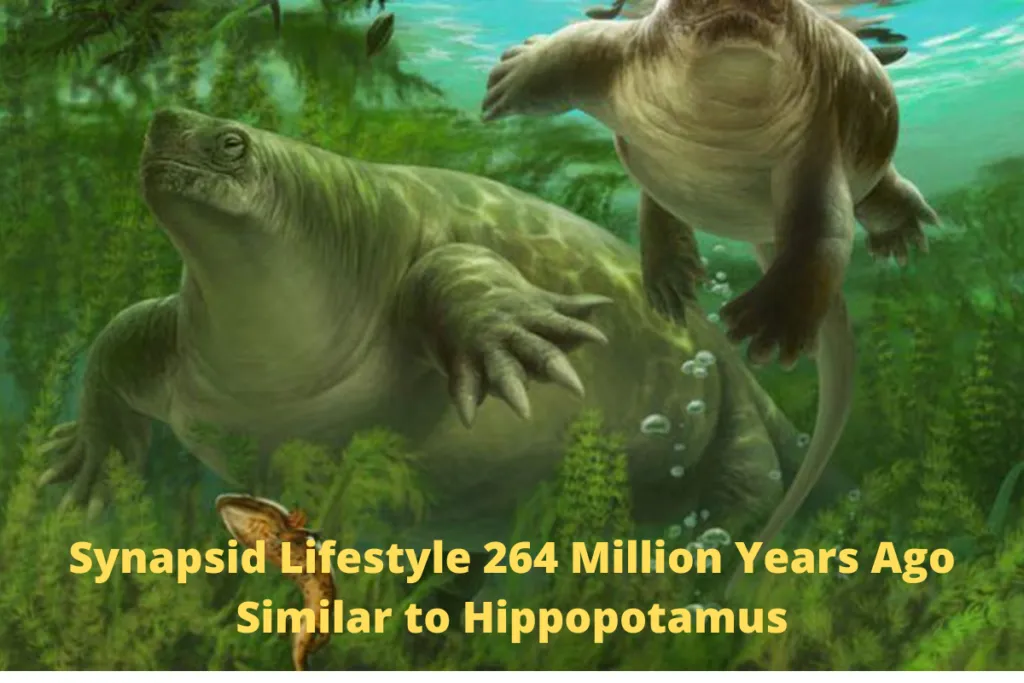TheMoonDay.Com…Synapsid Lifestyle Paleontologists have identified a new genus and species of caseid synapsids that lived 264 million years ago, during the Permian period. They analyzed a partial but well-preserved postcranial skeleton found in France. The ancient animal belongs to the Caseidae, a group of primitive synapsids (mammals and their close relatives) that existed from the Carboniferous to the Permian Age. This ancient animal, called Lalieudorhynchus gandi, lived in what is now France.
To note, synapsida or theropsida is a group of animals that includes mammals and all their close relatives in addition to other living amniotes. Lalieudorhynchus gandi lived during the Guadalupian epoch in the Permian period, about 264 million years ago.

“Caseidae were one of the first large herbivorous amniotes to evolve on the supercontinent Pangea,” wrote Ralf Werneburg of the Museum of Natural History at Castle Bertholdsburg Schleusingen and colleagues in their paper.
“These early synapsids are known from Pennsylvania in the United States, later in the Permian paleo-equatorial belt, from the United States to Siberia.” While the first caseids were small to medium in size, later forms acquired very peculiar body shapes.
Read More Article: 4 Most Expensive Snakes in the World
“With a large barrel-shaped trunk, a relatively small triangular skull with a large anatomy and leaf-like teeth, and large limbs ending with short fingers and powerful claws,” the researchers explain.
“Recently, many discoveries and re-descriptions allow for a better understanding of their paleobiodiversity and paleobiology, but their exact phylogenetic relationships remain under discussion.”
The partial skeleton of Lalieudorhynchus gandi was excavated in the La Lieude Formation, about 15 km south of Lodève in Occitanie, France. Despite their large size, the specimen exhibits an interesting mix of immature and mature features.
“A mixture of juvenile and adult features has been observed in other large caseid specimens,”
The paleontologist wrote. They explained that juvenile synapsids grow rapidly and mature individuals much more slowly. Delaying skeletal maturity will allow the caseid to reach very large sizes by having a long growth period.
“The coexistence of immature and mature features may be the result of a compromise between evolutionary constraints in the largest caseids, such as the need to grow sustainably and to support heavy loads,” the researchers said. The team’s analysis showed that Lalieudorhynchus gandi had a semi-aquatic lifestyle, much like modern hippos.
“Our anatomical and histological observations suggest that these caseids may have spent time underwater,” the researchers explain. “But our sedimentological analysis, along with related flora, suggests that it may have roamed the water beyond,”
Read More Article: Why the Author Changed the Original She-Hulk Story for a Serial Version
Synapsid Lifestyle 264 Million Years Ago Similar to Hippopotamus
According to them, the combination of adult ontogenetic characters and elderly individuals is consistent with the possibility of a semi-aquatic lifestyle. The authors also assessed the phylogenetic position of Lalieudorhynchus gandi within the group.
“Interestingly, Lalieudorhynchus gandi is closer to the North American caseid Cotylorhynchus hancocki than the other French caseids Ruthenosaurus and Euromycter from the Rodez Basin which are geographically closer,” they wrote. These last two caseids document Artinskian radiation from the clade, which remained diverse until the Olson extinction.
“Caseids survived, as Lalieudorhynchus gandi was one of the youngest representatives of the clade, and may have used new ecological strategies to access their vegetarian food source.” This research report was published in Palaeo Vertebrata under the title “A New caseid Synapsid from the Permian (Guadalupian) of the Lodève basin (Occitanie, France)” recently. The journal is open access that can be obtained online.
Despite their large size, the specimen exhibits an interesting mix of immature and mature features. “A mixture of juvenile and adult features has been observed in other large caseid specimens,” the paleontologist wrote.
Read More Article: Ben Affleck and J.Lo Hold a 3 Day Wedding
They explained that juvenile synapsids grow rapidly and mature individuals much more slowly. Delaying skeletal maturity will allow the caseid to reach very large sizes by having a long growth period.
“The coexistence of immature and mature features may be the result of a compromise between evolutionary constraints in the largest caseids, such as the need to grow sustainably and to support heavy loads,” the researchers said.
The team’s analysis showed that Lalieudorhynchus gandi had a semi-aquatic lifestyle, much like modern hippos.
“Our anatomical and histological observations suggest that these caseids may have spent time underwater,” the researchers explain.
“But our sedimentological analysis, along with related flora, suggests that it may have roamed the water beyond.”
According to them, the combination of adult ontogenetic characters and elderly individuals is consistent with the possibility of a semi-aquatic lifestyle. The authors also assessed the phylogenetic position of Lalieudorhynchus gandi within the group.
“Interestingly, Lalieudorhynchus gandi is closer to the North American caseid Cotylorhynchus hancocki than the other French caseids Ruthenosaurus and Euromycter from the Rodez Basin which are geographically closer,” they wrote.
These last two caseids document Artinskian radiation from the clade, which remained diverse until the Olson extinction.
“Caseids survived, as Lalieudorhynchus gandi was one of the youngest representatives of the clade, and may have used new ecological strategies to access their vegetarian food source.”
This research report was published in Palaeo Vertebrata under the title “A New caseid Synapsid from the Permian (Guadalupian) of the Lodève basin (Occitanie, France)” recently. The journal is open access that can be obtained online.
Buying Raphinha hasn’t been paid off yet, Leeds United are ready to case Barcelona
How America became the No.1 Superpower?| Reality of USA
Oscar-Winning Emma Stone Bio and Her Personal Life
Taylor Swift Ranked First Celebrity Biggest Carbon Emitter

Hey there, pals! I’m Fitri Wahyuni, the awesome author behind the cool stories you find on “The Moon Day” news website! From exciting sports updates to super fun Entertainment news, I’ve got you covered! But wait, there’s more! I also write about amazing Products and share helpful Health tips to keep you feeling your best. With a sprinkle of magic and a dash of fun, I bring all these stories to life for you to enjoy. So, grab a seat, get comfy, and let’s dive into a world of adventure, excitement, and maybe even a little bit of moonlight magic! 🌙✨









Hello themoonday.com admin, Your posts are always informative.